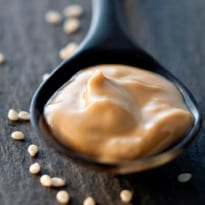Tahini is a protein-rich paste that adds a heavyweight presence to any dish.
It may look like an unpromising, oily, beige sludge, but the thick, stiff paste made from ground sesame seeds is a star ingredient that deserves a permanent place in the larder.
Thanks to its heavyweight presence, you only need a little tahini to add heft to an otherwise puny dish. Its mouth-coating, nutty taste is intense, yet supremely versatile. Just a dessertspoon, mixed with water, lemon juice and a hint of garlic, makes a lip-smacking dressing for salads, grilled or fried meat and falafels.
Without tahini, there's no hummus or baba ganoush. But you can also nudge it in a sweet direction. A Turkish market stallholder, selling his own tahini, recently told me how he eats it for breakfast, mixed with honey or pomegranate molasses, and spread on bread.
Why is tahini good for me?
Tahini contains more protein than milk and most nuts. It's a rich source of B vitamins that boost energy and brain function, vitamin E, which is protective against heart disease and stroke, and important minerals, such as magnesium, iron and calcium.
Most people prefer the paler type, made from hulled (skinned) seeds. The darker sort, made from unhulled sesame, is stronger-tasting and slightly bitter, but arguably healthier, because many of the nutrients are in the husk. An alternative view is that the fibre in the husk impairs mineral absorption. Either way, tahini is nutrient-dense.
Where to shop and what to pay?
Wholefood and Middle Eastern shops are the happiest hunting groundsfor tahini, often stocking a selection of brands. Even the most expensive tahini works out cheaply because the paste goes such a long way. Prices start at about £1.89 (270g) for a basic tahini, and go up to about £3, or thereabouts, for those that are both Fairtrade and organic.
• Joanna Blythman is the author of What To Eat (Fourth Estate, £9.99). To order a copy for £7.99 with free UK p&p, go to guardianbookshop.co.uk
Baked sesame and greek yoghurt cheesecake
This cheesecake would be a nice antidote to the classic Easter cake.
Serves 6-8
For the base
150g digestive biscuits
50g butter, melted
1 generous tbsp tahini
For the filling
350g cream cheese
250g Greek yoghurt
150g honey
3 eggs
2 tbsp cornflour, sifted
Juice and zest of 1 lemon
4 tbsp tahini
To finish
2 tbsp honey
2 tsp sesame seeds
1 Preheat the oven to 180C/350F/gas mark 4. Line a 20cm loose-based or springform cake tin.
2 Whizz the biscuits in a food processor until crumbed, add the butter and tahini until it all comes together.
3 Press into the base of the tin and put in the oven for 10 minutes while you make the filling. When you take the tin out, turn the oven down to 140C/275F/gas mark 1-2 and leave the door open to speed up the temperature reduction.
4 Rinse the food processor and put the cream cheese and Greek yoghurt in. Whizz for a couple of minutes until smooth and add the honey, eggs, cornflour, lemon zest and tahini and whizz again until you have a smooth batter. Pour on top of the base, return to the oven and bake for about an hour until just set. Turn the oven off and leave the cheesecake to cool inside.
5 Once cold, drizzle over the honey and scatter with sesame seeds.
• Rosie Sykes is head chef of Fitzbillies and co-author of The Kitchen Revolution (Ebury Press, £25). To order a copy for £19.99 with free UK p&p, go to guardianbookshop.co.uk
Photograph: Alamy












